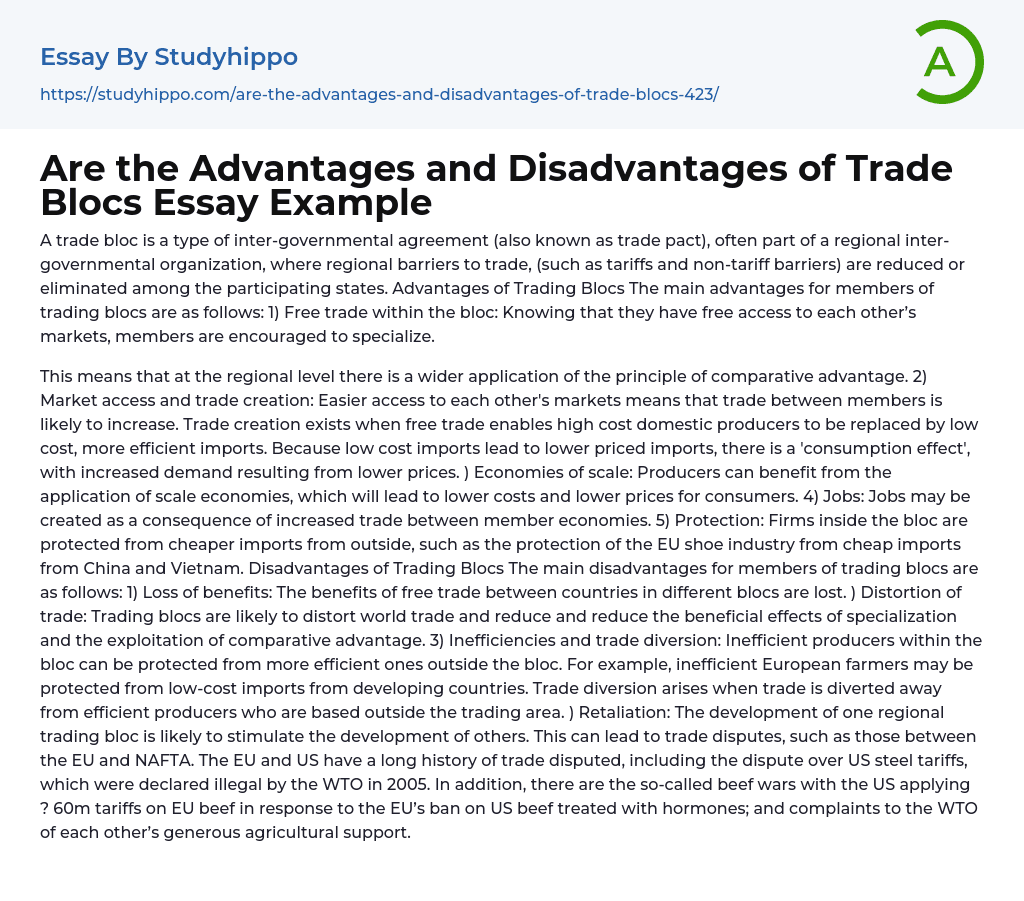

Are the Advantages and Disadvantages of Trade Blocs Essay Example
A trade bloc is a type of inter-governmental agreement (also known as trade pact), often part of a regional inter-governmental organization, where regional barriers to trade, (such as tariffs and non-tariff barriers) are reduced or eliminated among the participating states. Advantages of Trading Blocs The main advantages for members of trading blocs are as follows: 1) Free trade within the bloc: Knowing that they have free access to each other’s markets, members are encouraged to specialize.
This means that at the regional level there is a wider application of the principle of comparative advantage. 2) Market access and trade creation: Easier access to each other's markets means that trade between members is likely to increase. Trade creation exists when free trade enables high cost domestic producers to be replaced by low cost, more efficient imports. B
...ecause low cost imports lead to lower priced imports, there is a 'consumption effect', with increased demand resulting from lower prices. ) Economies of scale: Producers can benefit from the application of scale economies, which will lead to lower costs and lower prices for consumers. 4) Jobs: Jobs may be created as a consequence of increased trade between member economies. 5) Protection: Firms inside the bloc are protected from cheaper imports from outside, such as the protection of the EU shoe industry from cheap imports from China and Vietnam. Disadvantages of Trading Blocs The main disadvantages for members of trading blocs are as follows: 1) Loss of benefits: The benefits of free trade between countries in different blocs are lost. ) Distortion of trade: Trading blocs are likely to distort world trade and reduce and reduce the beneficial effects of specializatio
and the exploitation of comparative advantage. 3) Inefficiencies and trade diversion: Inefficient producers within the bloc can be protected from more efficient ones outside the bloc. For example, inefficient European farmers may be protected from low-cost imports from developing countries. Trade diversion arises when trade is diverted away from efficient producers who are based outside the trading area. ) Retaliation: The development of one regional trading bloc is likely to stimulate the development of others. This can lead to trade disputes, such as those between the EU and NAFTA. The EU and US have a long history of trade disputed, including the dispute over US steel tariffs, which were declared illegal by the WTO in 2005. In addition, there are the so-called beef wars with the US applying ? 60m tariffs on EU beef in response to the EU’s ban on US beef treated with hormones; and complaints to the WTO of each other’s generous agricultural support.
- American Dream essays
- Barriers To Entry essays
- Capitalism essays
- Central Bank essays
- Compensation essays
- Consumerism essays
- Economic Development essays
- Economic Growth essays
- Economic Inequality essays
- Economic System essays
- Economy essays
- Employment essays
- Export essays
- Finance essays
- Free Trade essays
- Gross Domestic Product essays
- Human Development essays
- Income Inequality essays
- Industry essays
- Inflation essays
- International Business essays
- International Trade essays
- Macroeconomics essays
- Materialism essays
- Max Weber essays
- Microeconomics essays
- Minimum Wage essays
- Monetary Policy essays
- Monopoly essays
- Pricing essays
- Profit essays
- Recession essays
- resources essays
- Taxation essays
- Trade essays
- Unemployment essays
- Warehouse essays
- World economy essays



